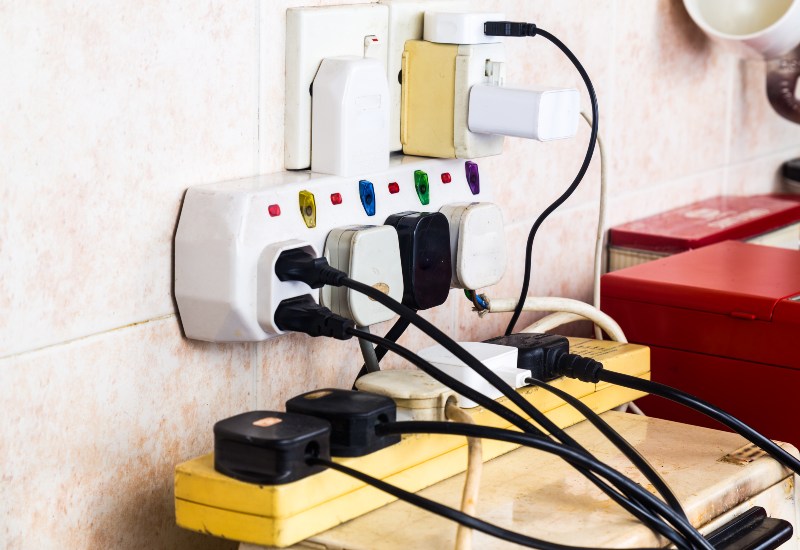Dangers of an Overloaded Circuit
Dangers of an Overloaded Circuit
Have you ever noticed your lights flickering or your circuit breaker tripping unexpectedly? These could be signs of an overloaded circuit, a common but often overlooked issue that can lead to serious problems. At Delta Electric, we’re here to make electrical safety easy to understand and manage. Today we’ll explore what causes overloaded circuits, why they’re dangerous, and how you can keep your home or business running smoothly and safely. With a little knowledge and the right support, protecting your property from electrical hazards is simpler than you think.
What is an Overloaded Circuit?
An overloaded circuit occurs when the electrical demand placed on a circuit exceeds its designed capacity. This happens when too many devices or appliances draw power from the same circuit, causing the wiring to overheat. Overloaded circuits can lead to significant issues, including tripped circuit breakers, damaged wiring, or even electrical fires. Knowing the signs of an overloaded circuit and addressing them promptly can prevent these problems from escalating.

Dangers of an Overloaded Circuit
The dangers associated with overloaded circuits are numerous and potentially severe. One of the most alarming risks is the possibility of electrical fires. When wires overheat due to excessive demand, they can ignite, posing a serious threat to your home or business. Additionally, overloaded circuits can damage sensitive electronics and appliances, often rendering them unusable or requiring costly repairs. Faulty wiring caused by overloading also increases the risk of electrical shocks, which can cause injury. Furthermore, circuit overloads can lead to power outages, leaving parts of your property without electricity and disrupting your daily routine or business operations.
Recognizing the Signs of an Overloaded Circuit
It is important to recognize the warning signs of an overloaded circuit to address the issue before it becomes a major hazard. Some common indicators include flickering or dimming lights, which occur when the circuit struggles to provide consistent power. Circuit breakers that trip frequently or fuses that blow often are another red flag, signaling that the electrical demand is too high for the circuit to handle. Buzzing sounds near outlets or switches, as well as warm or discolored outlets, are additional warning signs. In more severe cases, you may notice a burning smell emanating from electrical outlets or devices, which requires immediate attention.
How to Check for a Circuit Overload
Checking for a circuit overload involves a systematic approach to identifying the problem. Start by locating your electrical panel and identifying the specific circuit breaker that trips frequently. Once you’ve pinpointed the affected circuit, unplug all devices connected to it and take note of their wattage. Compare the total wattage of these devices to the circuit’s capacity, which is typically 15 or 20 amps. If the total wattage exceeds the circuit’s capacity, you’ve identified an overload. To confirm, you can plug devices back in one at a time while monitoring the circuit’s behavior.
Issues Caused by Circuit Overloads
The issues caused by circuit overloads extend beyond immediate inconveniences. Repeated overloading can wear out circuit breakers, reducing their effectiveness and increasing the likelihood of future problems. The excessive heat generated by overloaded circuits can melt or damage the insulation around wiring, creating additional fire hazards. Appliances and electronics connected to an overloaded circuit may also malfunction more frequently, leading to expensive repairs or replacements. These issues underscore the importance of addressing circuit overloads promptly and thoroughly.

How to Prevent Overloaded Circuits
Preventing overloaded circuits is an achievable goal with the right strategies. One of the most effective methods is to distribute electrical loads evenly across circuits, avoiding the use of multiple high-wattage devices on the same outlet or circuit. Having dedicated circuits for major appliances is an important strategy for preventing circuit overload. These kinds of appliances include refrigerators, electric stoves, electric ovens, air conditioners, electric furnaces, washers and dryers, and sump pumps. Upgrading your electrical panel can also help, especially if your property’s electrical system is outdated and unable to meet modern energy demands. Using high-quality surge protectors can manage sudden electrical surges and reduce the risk of overloading. Finally, scheduling regular inspections with a professional electrician ensures that your electrical system remains in good condition and capable of handling your energy needs.
Contact Delta Electric for Overloaded Circuit Solutions
If you’re dealing with an overloaded circuit or have concerns about your electrical system, Delta Electric is here to help. Our team of skilled electricians specializes in diagnosing and resolving issues related to overloaded circuits, ensuring your property remains safe and functional. Whether you’re looking for advice on how to fix an overloaded circuit or need professional intervention to address a persistent problem, we have the expertise to provide effective solutions.
Let’s Keep Your Property Safe!
Don’t let an overloaded circuit jeopardize your safety or disrupt your life. Contact Delta Electric today to learn more about our services. You can fill out our contact form or call us to speak with a member of our professional team. Let us help you maintain a safe and efficient electrical system that meets all your needs.
RECENT POSTS
categories
- Uncategorized
- Delta Electric
- Commercial Electrical
- Residential Electrical
- Electric Circuits
- Dedicated Circuits
- Circuit Breakers
- Electrical Panels
- Electrical Wiring
- Safety Inspections
- copper wires
- Electrician San Jose
- Trained Electricians
- Electrical Services San Jose
- Malfunctioning Electrical Outlets
- Circuit Breaker
- Grounding
- safety
- Flickering Lights
- Arc Fault Breakers
- electrical system
- Aluminum Wiring
- Circuit Interrupters
- House Surge Protection
- Zinsco Panel Warnings
- Wiring Conversion
- GFCI outlet
- professional electrician
- Knob-and-Tube Wiring
- modern home electrical system
- Fuses
- Electric Car Charger
- Electrical Repair
Archives
2025
2024
2023
2018
2017
- December (4)
- November (4)
- October (5)
- September (4)
- August (4)
- July (4)
- June (4)
- May (4)
- April (4)
- March (3)
- February (4)
- January (3)
2016
- December (3)
- November (4)
- October (4)
- September (4)
- August (4)
- July (4)
- June (4)
- May (4)
- April (4)
- March (4)
- February (4)
- January (4)
2015
- December (4)
- November (4)
- October (4)
- September (4)
- August (3)
- July (4)
- June (4)
- May (3)
- April (4)
- March (4)
- February (2)
2014
- December (3)
- November (4)
- October (4)
- September (6)
- August (2)
- July (3)
- May (2)
- April (1)
- March (2)
- February (1)
- January (1)

